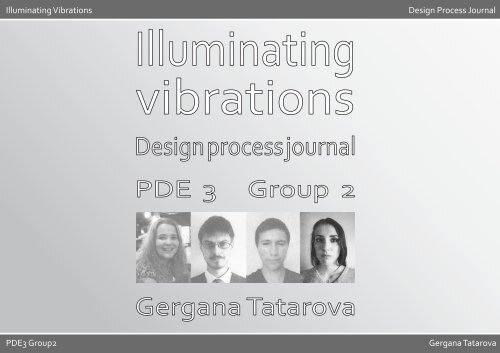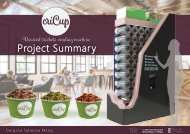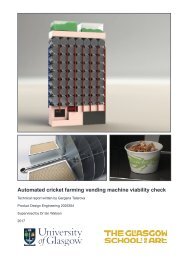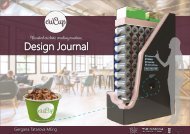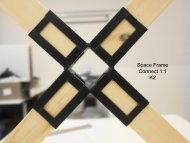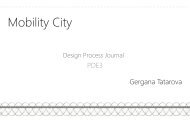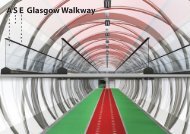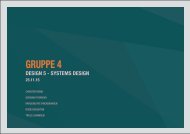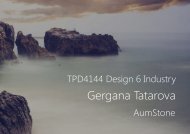GerganaT_ILLUMvibr_PrDesVER02
Create successful ePaper yourself
Turn your PDF publications into a flip-book with our unique Google optimized e-Paper software.
Illuminating Vibrations<br />
Illuminating<br />
Design Process Journal<br />
Gergana Tatarova<br />
Illuminating Vibrations<br />
Group 2 PDE3<br />
vibrations<br />
Design process journal<br />
PDE 3 Group 2<br />
Gergana Tatarova<br />
PDE3 Group2<br />
Gergana Tatarova
Illuminating Vibrations<br />
Outline<br />
We had to design and construct a musical<br />
instrument to be presented in science<br />
festivals during The Year of Light 2015*. The<br />
instrument should use lasers and should<br />
promote the relationship between Art and<br />
Science. The product might be used for<br />
school presentations to encourage the study<br />
of Science, Technology, Engineering, the<br />
Arts and Mathematics (STEAM) through<br />
demonstration of light based technologies.<br />
*On 20 December 2013, The United Nations<br />
(UN) General Assembly 68th Session<br />
proclaimed 2015 as the International Year of<br />
Light and Light-based Technologies (IYL 2015)<br />
Approach<br />
We were divided in teams and given different<br />
research areas. We had a week to visit relevant<br />
sites, talk to appropriate people, investigate<br />
complex technological concepts. Then we<br />
produced a presentation in order to share all<br />
we found with the other groups and in return<br />
use what they researched.<br />
We had half a day to process the information,<br />
then had to produce 20 concepts per group.<br />
Evaluate them, choose 3 - develop them<br />
further. Chose one - develop, build, develop.<br />
Stakeholders, user experience, safety and<br />
manufacturing processes were taken into<br />
account at every stage.<br />
Research groups<br />
Music Technology<br />
Group 5<br />
Project Launch<br />
Group 1<br />
International Year of<br />
Light<br />
Interactive exhibit for<br />
science museum<br />
Portable kit for<br />
schools/science<br />
festivals<br />
RESEARCH<br />
BANK<br />
What’s been done<br />
Group 6<br />
Group 2<br />
Laser Harp Technology<br />
Performing music<br />
STEM/STEAM<br />
Group 3<br />
Safety & ILDA<br />
Design Process Journal<br />
Gergana Tatarova<br />
Illuminating Vibrations<br />
Group 2 PDE3<br />
My teammates and I researched<br />
different laser harps - framed,<br />
unframed, full-colour; different<br />
strengths laser beams used,<br />
diffraction of beam methods. Midi<br />
controllers, software functions.<br />
Science festivals exhibit safety<br />
requirements, target audience,<br />
portability and power supplies<br />
options.<br />
We talked to Dr Fells, Glasgow Uni<br />
professor, having music and light<br />
related side projects.<br />
The investigation process gave<br />
us a good start into the project<br />
and deepened our interest and<br />
understanding.<br />
Group 4<br />
Each team presentation was very informative and at the same time made attractive to the audience. I learnt a lot of useful and relevant to the project information.<br />
Now it was time to channel it so that we can make best use of it.<br />
PDE3 Group2<br />
Gergana Tatarova
Illuminating Vibrations<br />
Channelling the new information<br />
Post it!<br />
After each team had given their research<br />
containing presentations, we had to sit<br />
down and process everything we learnt.<br />
My team worked together with Group 1.<br />
We started by writing down on post-it<br />
notes everything we remembered and<br />
made an impression to us.<br />
After a discussion and quite a few more<br />
post-it, we managed to put them into<br />
different categories in order to tidy our<br />
sheet and heads.<br />
Design Process Journal<br />
Gergana Tatarova<br />
Illuminating Vibrations<br />
Group 2 PDE3<br />
Both teams<br />
agreed that<br />
User-centred<br />
design<br />
is our aim.<br />
Timeline of events<br />
We also had to come up with an example<br />
timeline of a day the product is used.<br />
This provoked us to think of possible problems and<br />
solutions we haven’t thought of before<br />
After discussing, brainstorming,<br />
analysing,<br />
discussing,<br />
brainstorming, discussing and<br />
analysing again, together with<br />
Group 1, we had sufficient<br />
knowledge to start coming up<br />
with ideas and generate concepts.<br />
PDE3 Group2<br />
Ready to<br />
generate<br />
ideas!<br />
Ready for the next stage - each team<br />
had to design 20 concepts. Having 4<br />
members in our, we decided to split<br />
the task up and each member to<br />
produce 5 concepts.<br />
Gergana Tatarova
Illuminating Vibrations<br />
5 Personal suggestions<br />
Concepts generation and evaluation<br />
Design Process Journal<br />
Gergana Tatarova<br />
Illuminating Vibrations<br />
Group 2 PDE3<br />
1. Triangle using transparent plastic/glass with a laser beam<br />
following the shape. Doesn’t change it’s function, just<br />
appearance.<br />
2. A permanent exhibit in a e.g. Science Museum. Striped<br />
coloured carpet indicating different notes from a scale. Moving<br />
on it simulates playing an instrument. Lasers constantly scan<br />
the room to collect information and produce relevant sound.<br />
3. Performance - a dancer having her costume made out of<br />
safe lasers, dancing in front of curved reflective surface for<br />
bigger effect.<br />
4. Environmental awareness modern art exhibit. Reflective<br />
rubbish (i.e.. aluminium cans, plastic bags and packages) in a<br />
big bowl. A round structure above it with several laser beams<br />
pointed towards the rubbish. The lasers react to music played<br />
- they change speed/intensity/colour.<br />
PDE3 Group2<br />
5. Big laser harp using people to break the beams. They wear<br />
protective hats.<br />
It might be used in a TV show or again a performing rehearsed<br />
act bringing beautiful music in a new manner.<br />
Thinking back...<br />
Am I happy with what I came up?<br />
I remember, while looking at all my classmates concepts,<br />
feeling a bit envious and sad seeing some really clever ideas.,<br />
considering mine pretty trivial.<br />
Getting quite a lot of positive points did make me feel better,<br />
although non of my concepts got to the top 3. I think because<br />
of them not being easy at all to built.<br />
Would it have been possible to come up with with better<br />
ideas?<br />
Maybe... After all of 3rd’s year research and user orientated<br />
aquired knowledge, especially Brian’s lectures, I think I<br />
might have extracted the research better to produce more<br />
appropriate concepts<br />
Gergana Tatarova
Illuminating Vibrations<br />
Concepts evaluation<br />
Concepts generation and evaluation<br />
Further reflections<br />
Design Process Journal<br />
Gergana Tatarova<br />
Illuminating Vibrations<br />
Group 2 PDE3<br />
After every team had produced their 20, all the concepts were exhibited, ready<br />
for peer evaluation - every student had 3 sticky dots to put on the concept<br />
they liked the most.<br />
It was really interesting to see how many different ideas were generated this<br />
way. I enjoyed that activity - producing the concepts, looking around others,<br />
and receiving dots :)<br />
After it was done, my team and I discussed important criteria for the final<br />
product - we shortlisted 10 concepts which were more relevant and feasible -<br />
they can be seen in the team design folio.<br />
We put them in a table, which we evaluated in different weighted categories<br />
(Portability, Safety, Aesthetics, Interactivity, Novelty, Interest, Feasibility,<br />
Suitability) to choose the most suitable 3 to continue.<br />
Having received my feeback and rereading the brief after the project have finished, I do realise we could<br />
have chosen better evaluation criteria. I agree with the statement that we concentraded more on the<br />
technical side forgetting to put emphasis on the user experience, in contradiction with our initial planning.<br />
We did include Interactivity and Interest, but we should have thought more about different user types in<br />
variety of contexts and based our evaluation table on them.<br />
Top 3 concepts<br />
Although my ideas got the most ‘approval dots’, after discussion and<br />
evaluation, we decided they aren’t the most appropriate in terms of feasibility<br />
and suitability for the project.<br />
After having 3 concepts to choose from, we had a team discussion where we decided to have a day of research about building requirements of each concept. We wanted to have an interesting and<br />
relatively complex prototype, but we did not want to get stuck in something nearly impossible to build regarding the time and facilities we had.<br />
All of us liked the idea of incorporating laser drawing into music. And Christian had already bought the laser, we got some phosphorescent paint and tonic and the effect was pretty cool. We decided<br />
we are building the refraction bowl!<br />
PDE3 Group2<br />
Gergana Tatarova
Illuminating Vibrations<br />
The journey...<br />
Building the prototype<br />
Design Process Journal<br />
Gergana Tatarova<br />
Illuminating Vibrations<br />
Group 2 PDE3<br />
THE CHOSEN CONCEPT<br />
We experimented with different dimensions.<br />
Took into account the web camera angle<br />
view, the perfect distance from laser to liquid<br />
and from liquid to drawing surface, that will<br />
give us the best diffraction, as well as safety<br />
- we didn’t want to put the laser very high so<br />
that kids would be able to look directly into it.<br />
Christian made a<br />
scaled model of<br />
the prototype,<br />
everyone was<br />
happy with it, and<br />
we decided to<br />
take it full scale!<br />
Cardboard box sections were<br />
good enough to support the<br />
whole structure... and free!<br />
So we started building!<br />
The bowl was vacuum<br />
formed in the workshop<br />
using clear acrylic sheet.<br />
We experimented<br />
with different liquid<br />
and decided to use<br />
Tonic due to its<br />
quinine content effect<br />
together with our UV<br />
laser. And it’s safe!<br />
We played around with<br />
other options as the main<br />
liquid - phosphorescent<br />
paint mixed with water. fun!<br />
but not the best option.<br />
Everyone researched, and we found<br />
the most appropriate software for the<br />
task. Daniel installed and everything<br />
seems to be going great!<br />
It worked!<br />
Fluorescence happened!<br />
Software worked!<br />
Sound worked!<br />
Prototype successful!<br />
Well done, team!<br />
Rest deserved!<br />
Cardboard did the<br />
job! Prototype to<br />
scale, ready and<br />
sturdy as a police<br />
horse.<br />
PDE3 Group2<br />
Gergana Tatarova
Illuminating Vibrations<br />
After successfully building the prototype, as a team we<br />
decided that every member should come up with two final<br />
versions of the product, then evaluate them, merge some of<br />
them and decide on a final one. Always taking into account<br />
human experience and interaction, aesthetics and sensory<br />
design.<br />
Product Development<br />
Design Process Journal<br />
Gergana Tatarova<br />
Illuminating Vibrations<br />
Group 2 PDE3<br />
I decided that round base instead<br />
of rectangular is a smarter option<br />
for an exhibit, since people will<br />
be the same distance from the<br />
centre of it, no matter where they<br />
are standing.<br />
Other team members agreed.<br />
Another suggestion I had was<br />
to incorporate a glove into the<br />
design. This way we can use any<br />
kind of liquid without safety<br />
concerns or any spillage.<br />
The other members preferred<br />
that we keep the contact with the<br />
fluid.<br />
Here are my interpretation of the current prototype,<br />
solution ideas, and my two final product suggestions.<br />
PDE3 Group2<br />
Gergana Tatarova
Illuminating Vibrations<br />
Again, together as a team, we<br />
sat down, discussed everyone’s<br />
suggestions and came up with the<br />
final version of our product.<br />
I came up with the<br />
name and the logo,<br />
but apparently no<br />
one was fan of it.<br />
Plus, it’s supposed<br />
to be neon green<br />
as it represents<br />
the trace left by<br />
the beam, but it<br />
cannot be printed<br />
this way, so it’s<br />
harder to convey<br />
the idea. At least<br />
the name stayed.<br />
The final product<br />
User experience<br />
We all agreed that the last version of the product<br />
looks elegant, but at the same time inviting being<br />
entertaining, and moreover, safe to use.<br />
Beam & Tonic works by shining a low power, safe<br />
laser beam downwards through a fluid onto a<br />
phosphorescent plate. The user interacts with the<br />
liquid thus changing the level of refraction of the<br />
laser beam, resulting in a dynamic displacement<br />
of the laser point on the plate.<br />
The camera records the coordinates of the<br />
moving point at any instant and converts the<br />
patterns into a synthesised tone.<br />
The position might control just pitch and volume<br />
- we call it the basic function. But it might be<br />
connected to an outer source - microphone, el<br />
guitar, and the position then controlling echo or<br />
distortion or anything you want.<br />
Design Process Journal<br />
Gergana Tatarova<br />
Illuminating Vibrations<br />
Group 2 PDE3<br />
We altered the initial dimensions a bit (engineering drawing follows), since most<br />
of the safety issues were resolved by having the acrylic protector shield.<br />
Modularity<br />
It disassembles to three<br />
main components:<br />
-Lower body (containing<br />
camera and fluorescent<br />
surface)<br />
-Bowl with hand cut-outs<br />
-Upper body (containing<br />
laser and batteries)<br />
Beam ’n’ Tonic<br />
PDE3 Group2<br />
Gergana Tatarova
Illuminating Vibrations<br />
Engineering drawing, general assembly & cost<br />
Materials:<br />
1<br />
Design Process Journal<br />
Gergana Tatarova<br />
Illuminating Vibrations<br />
Group 2 PDE3<br />
Laser emitter<br />
& rechargeable<br />
batteries<br />
2<br />
Outer shell<br />
1<br />
Locking ring<br />
2<br />
Hand cut outs<br />
connected to Fluid<br />
bowl<br />
1<br />
Locking ring<br />
2<br />
Materials:<br />
Manufacture, Finishing, Cost<br />
1.Brushed Aluminium sheet 3mm<br />
- rolled, TIG welding, Plasma cutting<br />
2.Transperant Acrylic sheet 3mm<br />
- rolled, Laser cutting, Hot Air Plastic welding£15<br />
- Vacuum formed bowl and cone<br />
£5<br />
3.Other total - £250<br />
£250<br />
3xSpeakers<br />
£75<br />
Total: £790<br />
Camera<br />
£20<br />
+error £10<br />
Laser<br />
£100<br />
Fluorescent paint £10<br />
£800<br />
Raspberry Pi £50<br />
Rechargeable batteries £15<br />
Bolts, Wires etc.<br />
£10<br />
£250<br />
£50<br />
£220<br />
2<br />
2<br />
1<br />
Phosphorescent<br />
plate<br />
Receiver cone<br />
(camera)<br />
Outer shell<br />
Perforation for<br />
sound enhancement<br />
Speakers<br />
Electronics housing<br />
PDE3 Group2<br />
Gergana Tatarova


